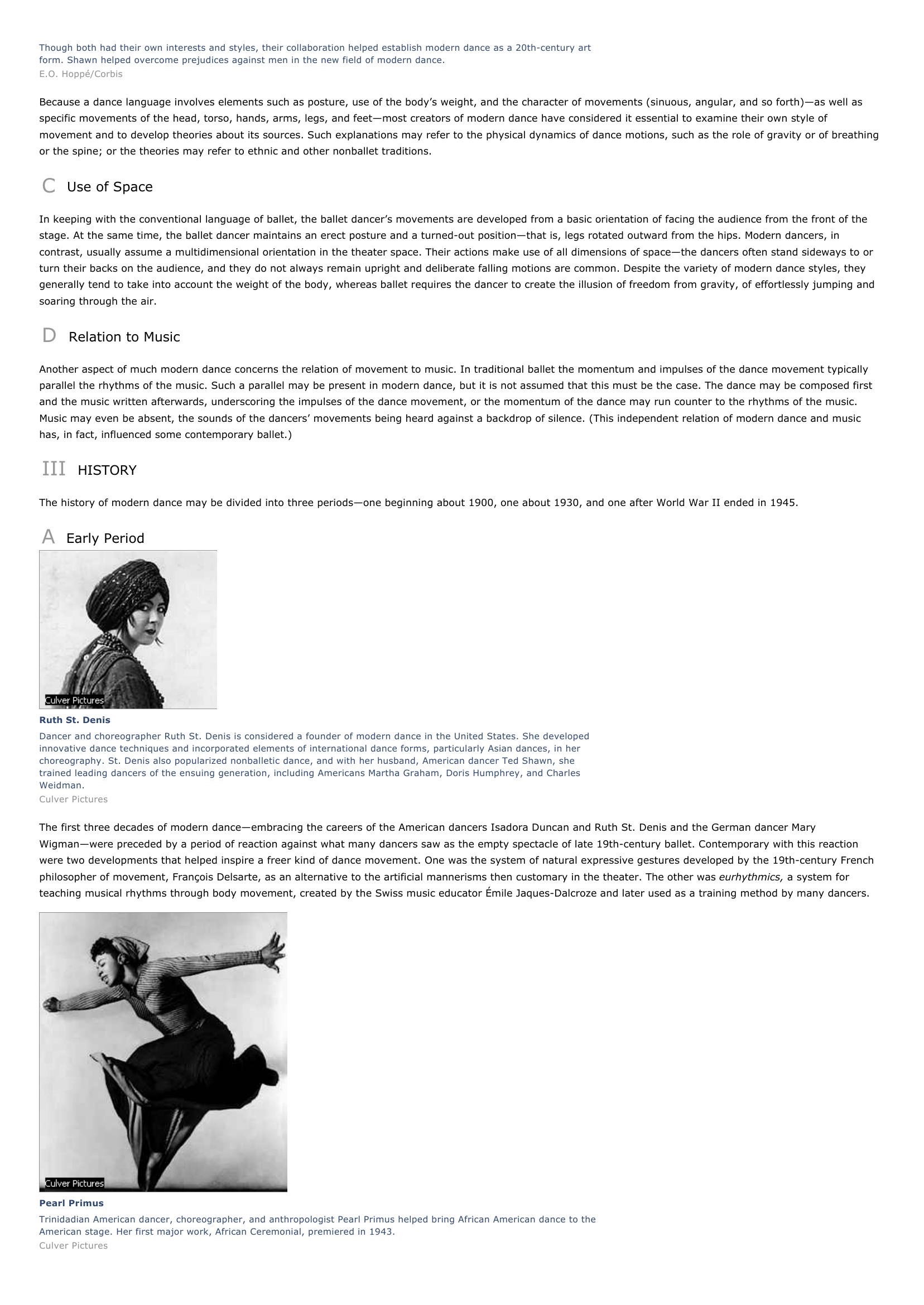Modern Dance I INTRODUCTION Modern Dance, tradition of theatrical dance unique to the 20th century.
Publié le 12/05/2013

Extrait du document
«
Though both had their own interests and styles, their collaboration helped establish modern dance as a 20th-century artform.
Shawn helped overcome prejudices against men in the new field of modern dance.E.O.
Hoppé/Corbis
Because a dance language involves elements such as posture, use of the body’s weight, and the character of movements (sinuous, angular, and so forth)—as well asspecific movements of the head, torso, hands, arms, legs, and feet—most creators of modern dance have considered it essential to examine their own style ofmovement and to develop theories about its sources.
Such explanations may refer to the physical dynamics of dance motions, such as the role of gravity or of breathingor the spine; or the theories may refer to ethnic and other nonballet traditions.
C Use of Space
In keeping with the conventional language of ballet, the ballet dancer’s movements are developed from a basic orientation of facing the audience from the front of thestage.
At the same time, the ballet dancer maintains an erect posture and a turned-out position—that is, legs rotated outward from the hips.
Modern dancers, incontrast, usually assume a multidimensional orientation in the theater space.
Their actions make use of all dimensions of space—the dancers often stand sideways to orturn their backs on the audience, and they do not always remain upright and deliberate falling motions are common.
Despite the variety of modern dance styles, theygenerally tend to take into account the weight of the body, whereas ballet requires the dancer to create the illusion of freedom from gravity, of effortlessly jumping andsoaring through the air.
D Relation to Music
Another aspect of much modern dance concerns the relation of movement to music.
In traditional ballet the momentum and impulses of the dance movement typicallyparallel the rhythms of the music.
Such a parallel may be present in modern dance, but it is not assumed that this must be the case.
The dance may be composed firstand the music written afterwards, underscoring the impulses of the dance movement, or the momentum of the dance may run counter to the rhythms of the music.Music may even be absent, the sounds of the dancers’ movements being heard against a backdrop of silence.
(This independent relation of modern dance and musichas, in fact, influenced some contemporary ballet.)
III HISTORY
The history of modern dance may be divided into three periods—one beginning about 1900, one about 1930, and one after World War II ended in 1945.
A Early Period
Ruth St.
DenisDancer and choreographer Ruth St.
Denis is considered a founder of modern dance in the United States.
She developedinnovative dance techniques and incorporated elements of international dance forms, particularly Asian dances, in herchoreography.
St.
Denis also popularized nonballetic dance, and with her husband, American dancer Ted Shawn, shetrained leading dancers of the ensuing generation, including Americans Martha Graham, Doris Humphrey, and CharlesWeidman.Culver Pictures
The first three decades of modern dance—embracing the careers of the American dancers Isadora Duncan and Ruth St.
Denis and the German dancer MaryWigman—were preceded by a period of reaction against what many dancers saw as the empty spectacle of late 19th-century ballet.
Contemporary with this reactionwere two developments that helped inspire a freer kind of dance movement.
One was the system of natural expressive gestures developed by the 19th-century Frenchphilosopher of movement, François Delsarte, as an alternative to the artificial mannerisms then customary in the theater.
The other was eurhythmics, a system for teaching musical rhythms through body movement, created by the Swiss music educator Émile Jaques-Dalcroze and later used as a training method by many dancers.
Pearl PrimusTrinidadian American dancer, choreographer, and anthropologist Pearl Primus helped bring African American dance to theAmerican stage.
Her first major work, African Ceremonial, premiered in 1943.Culver Pictures.
»
↓↓↓ APERÇU DU DOCUMENT ↓↓↓
Liens utiles
- Modern Art I INTRODUCTION American Gothic American Gothic was painted by the 20th-century American artist Grant Wood in 1930.
- Igor Stravinsky I INTRODUCTION Igor Stravinsky (1882-1971), Russian American composer, one of the most influential figures of music in the 20th century.
- Indian Music I INTRODUCTION Classical Dance of South India The southern Indian kathakali is a dance drama that dates from the 17th century.
- Art Nouveau I INTRODUCTION Detail of Art Nouveau Decoration This detail of a door decoration from a building constructed in the early 20th century in Milan, Italy, illustrates the stylistic themes associated with art nouveau.
- Winston Churchill I INTRODUCTION Winston Churchill (1874-1965), British politician and prime minister of the United Kingdom (1940-1945, 1951-1955), widely regarded as the greatest British leader of the 20th century.





